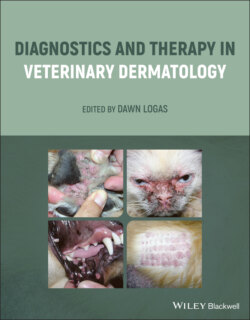Читать книгу Diagnostics and Therapy in Veterinary Dermatology - Группа авторов - Страница 3
List of Tables
Оглавление1 Chapter 1Table 1.1 Cells of the innate and adaptive immune system discussed in this ...
2 Chapter 3Table 3.1 Common diagnostic tests available in veterinary dermatology. This...
3 Chapter 5Table 5.1 Example of methicillin‐resistantStaphylococcus pseudintermedius s...Table 5.2 Potential systemic antimicrobial options for treatment of antimic...
4 Chapter 6Table 6.1 Laboratories for oomycete/fungal diagnostics.a
5 Chapter 8Table 8.1 Clinical staging of canine and feline leishmaniasis.Table 8.2 Approved drugs for the treatment of canine and feline leishmanias...Table 8.3 Antifungal drugs with high to moderatein vitro activity against S...Table 8.4 Treatments for canine and feline sporotrichosis.Table 8.5 Bartonella species found in cats and dogs.Table 8.6 Clinical signs associated with commonBartonella species.Table 8.7 Reported treatments for bartonellosis in cats and dogs.
6 Chapter 9Table 9.1 List of major therapeutics for atopic dermatitis.
7 Chapter 10Table 10.1 Clinical reaction patterns in hypersensitive cats.Table 10.2 Recommended antibiotic doses for cats.Table 10.3 Diagnostic criteria for nonflea feline hypersensitivity.Table 10.4 Recommended antihistamine doses for cats.
8 Chapter 11Table 11.1 Dosing of immunosuppressive medications for autoimmune diseases.Table 11.2 Sample glucocorticoid tapering schedule.Table 11.3 Diagnostic ruleouts for sterile pyogranulomatous panniculitis.
9 Chapter 12Table 12.1 Medications that affect thyroid diagnostic testing.Table 12.2 Interpretations of thyroid diagnostic testing results.
10 Chapter 13Table 13.1 Definition of acute and chronic otitis.Table 13.2 Underlying causes of otitis.
11 Chapter 16Table 16.1 Contributors to antimicrobial resistance.Table 16.2 Enzymatic Comprehensive list of historical and contemporary anti...Table 16.3 Potential impact of antimicrobial drug resistance.Table 16.4 Practices to decrease antibiotic resistance now.
12 Chapter 18Table 18.1 Commonly used oral glucocorticoids in the dog.Table 18.2 Commonly used oral glucocorticoids in the cat.
13 Chapter 19Table 19.1 Drug withdrawal times prior intradermal testing.
14 Chapter 22Table 22.1 Indications for photobiomodulation.
15 Chapter 23Table 23.1 Drugs that can be used for sedating dermatologic patients.Table 23.2 Suitability of sedative drugs for skin testing in small animals.Table 23.3 Induction agents for dermatologic patients.Table 23.4 Recommended maximum dose for the commonly used local anesthetics...Table 23.5 Nonsteroidal anti‐inflammatory drugs (NSAIDs) approved for dogs ...
